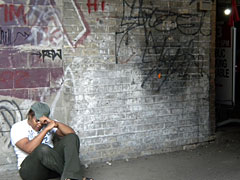
An estimated 22,000 youth are runaway or homeless each year in Minnesota. The most common reason for homeless youth, cited by the MN Department of Human Services, is a background of poverty, family conflict, abuse, mental illness or chemical dependency.
The Kulture Klub Collaborative is an independent nonprofit arts organization that brings together artists and homeless teens in Minneapolis. Through workshops and cultural presentations, homeless teens develop their creative expression and receive exposure to artistic excellence. The organization serves as a bridge for at-risk youth to express their voice in their communities.
Each year, Mike Hoyt, the Director of Kulture Klub, selects four professional artists to create projects with the youth. As one of this year's selected Artist In Residence, I asked myself a question: 'How do I infuse public art with information, in a manner that immediately engages the general public?' With that question in mind I proposed the Home Is Where You Make It public art project .

Because Public Art is generally viewed by people in transit, I knew the work needed to be easily readable, dynamic and informative. The Home Is Where You Make It project was intended to build public awareness about the homeless youth crisis by literally giving a face to an invisible issue. As a team, the Kulture Klub Collaborative and I would build houses that were covered with photographs and poems, conveying the youth's idea of 'home'.
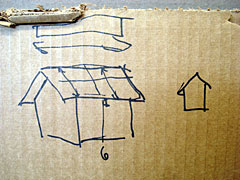
For the construction of the houses I wanted to create shelter in a way that was consistent with the materials used by homeless people throughout the world; cardboard and plastic. These materials are durable, flexible, portable and reusable. It is important to note that, due to their ingenuity, homeless people are the predecessors of the Green, Sustainable, Pre-Fab design movement.
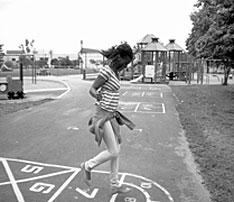
Time was of the essence due to a three week production schedule which required photographing, construction and installation. The most important key to success was the kids themselves. Without their understanding, participation and enthusiasm, the project would fail. The daily workshop alternated between writing exercises with spoken word artist Tish Jones and photography instruction and shooting on my end.

In order for the youth to shoot compelling images, they needed to learn how to use the Nikon digital cameras and become familiar with various photography genres. Once the photo basics were covered, the youth compiled a list of locations throughout the city that they felt illustrated their idea of home. For four days we photographed the people and surrounding landscapes of each location.
The second week of production was dedicated to the physical construction of the houses. Megan Madland, the project's architect, designed the 5' x 8' feet houses. The 'Shotgun' style house design was chosen because it is the most recognizable housing design in the world. The term Shotgun style refers to the sensibility that the houses are so small, that a single bullet could penetrate the front of the house and go straight through the back.
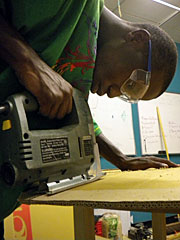
The task of construction was a team effort by all involved, but could not have been realized without the youth's workmanship . The houses were constructed with 2-ply cardboard and small plastic ties for added stabilization. To keep the houses erect, Megan created an introverted dovetail design with interlocking joints. The joints could only be seen and accessed on the inside of the house. The interlocking design was not only aesthetically pleasing but also a form of protection for the houses. In order for someone to disassemble the houses, they would literally have to flip the houses over and take them apart piece by piece.
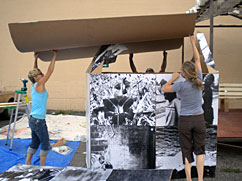
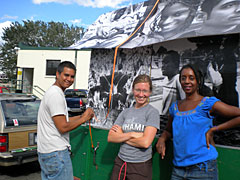
After the construction, each house was completely covered with large scale digital black and white photographs and poems, and completed with a polyurethane finish. The final assemblage of the houses required a team effort to interlock and tie all the components of each house together as a whole. The next step was to individually load each house onto a wagon and deliver them to the public locations.
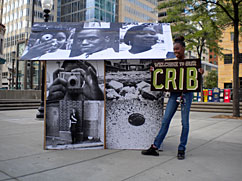
The houses were displayed in pedestrian areas such as Peavey Plaza, Loring Park, and Intermedia Arts. For a personal touch each house was outfitted with welcome mats that read 'Welcome to Our Crib'. To my surprise the welcome mats were immediately stolen!

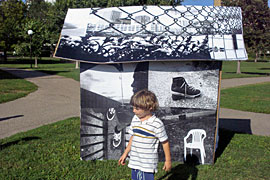
During the installations I began to notice a metamorphosis of the youth. When the public began to explore the houses, the youth would excitedly explain in great detail their intention for the project and the artistic process behind it. The same teenagers who were previously nonchalant were now proud artists!
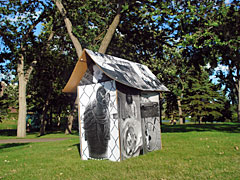
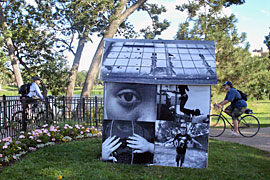
After the successful installations, the project received great public responses and press. We were all feeling quite proud of ourselves. Next on our schedule was a grand presentation at the Walker Art Center. The Walker Art Center is arguably one of the best contemporary art museums in the world.
The day before the Walker presentation the unimaginable occurred. Two tornados touched down in the Minneapolis metropolitan area, tore the roofs off of houses and uprooted trees and sidewalks. Believe it or not, despite all of the chaos and destruction in the city, our cardboard houses were still standing!

After much impromptu scrambling we transported all of the houses into the Walker. The youth and I presented the work to a capacity-filled auditorium, answered questions, recited poetry and even danced. The audience was moved to both tears and laughter. Later it would be stated that the weather beaten houses were a metaphor for the kids lives; weathered but still standing.
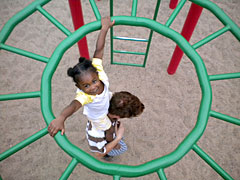
Home is Where You Make It became more than a public art project, it became a catalyst for community engagement. Shelter is a fundamental human right that should be available for all. Through art the voices of society's most vulnerable members, the youth, can be witnesses to the world.


For many of the Kulture Klub youth, the production of Home Is Where You Make It and the public reception was a grand moment of achievement and recognition, they will never forget. As adults we often forget how the power of affirmation can transform a young person's life for the better. The Kulture Klub Collaborative and Mike Hoyt, realize that the arts and mentorship have the power to change our youth and communities.
Today, the definition of how well we live should equate to the quality of our community as a physical and emotional whole. Home is not only where you make it but it is also what you make it.
You can now purchase a copy of the Home Is Where You Make It book. Proceeds will benefit the Kulture Klub organization.
The Home Is Where You Make It project was sponsored by the Leonard Nimoy Foundation and the Millennium Hotel. Concept inspired by John Paul Pietrus. Images in this article are the copyright of Lauri Lyons and the Kulture Klub Collaborative.
Lauri Lyons is a photographer, artist and author. Her books include Flag: An American Story and Flag International